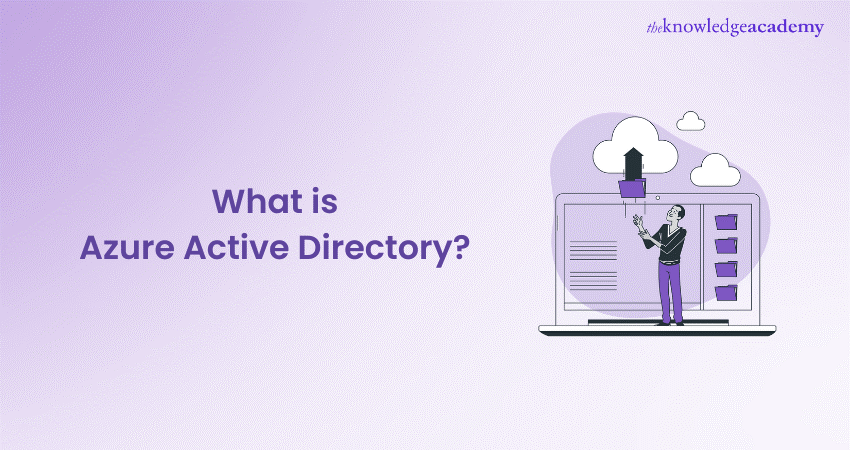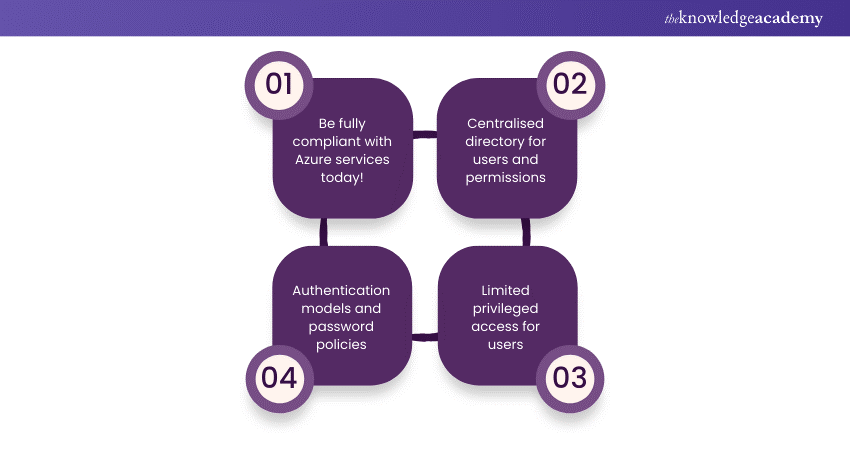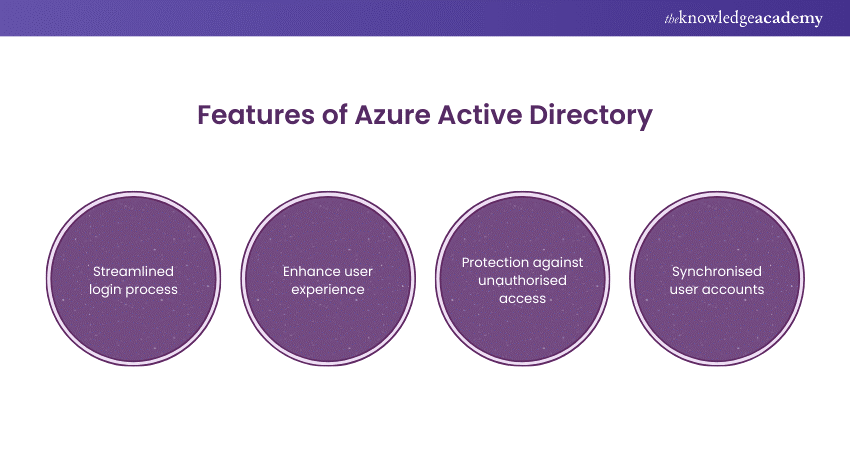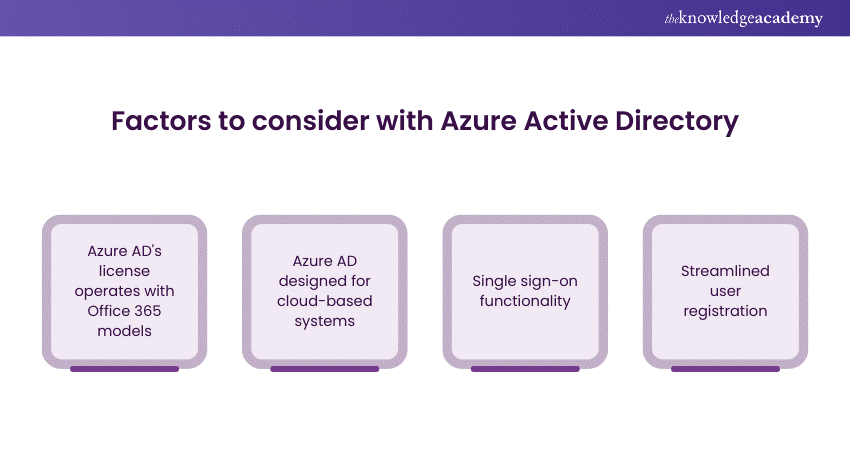We may not have the course you’re looking for. If you enquire or give us a call on 01344203999 and speak to our training experts, we may still be able to help with your training requirements.
Training Outcomes Within Your Budget!
We ensure quality, budget-alignment, and timely delivery by our expert instructors.
- Designing and Implementing Enterprise-Scale Analytics Solutions Using Microsoft Azure and Microsoft Power BI DP500
- Microsoft Azure Administrator AZ104
- Data Engineering On Microsoft Azure DP-203 Certification
- Microsoft Azure Security Technologies AZ500
- Designing And Implementing Microsoft DevOps Solutions AZ400

Azure Active Directory (Azure AD) is Microsoft’s multi-tenant, cloud-based directory and identity management service. It empowers organisations by allowing employees to sign in to multiple services and access them seamlessly across the cloud using a single set of login credentials. Whether it is for cloud applications or mobile apps, Azure AD provides a ready-made solution for authentication, simplifying access management and enhancing security.
Table of Contents
1) What is Azure Active Directory?
2) What is Windows Active Directory?
3) How does Azure Active Directory work?
4) Features of Azure Active Directory
5) Contrasting Windows AD and Azure AD
6) Factors to consider with Azure Active Directory
7) Conclusion
What is Azure Active Directory?
Azure Active Directory (Azure AD) is Microsoft’s cloud-based identity and access management service. Its purpose is to simplify and secure access to resources within your organisation, whether they reside on-premises or in the cloud. Azure AD effectively manages access to various resources, including applications, devices, and data.
The key features of Azure AD include:
a) Central repository for user identities: Azure AD serves as a central repository where user identities are securely stored. Organisations can efficiently manage access to applications and resources across the Azure cloud environment.
b) Authentication methods: Azure AD supports a range of authentication methods, from traditional username and password to more robust options like multi-factor authentication. Additionally, it integrates with social identity providers such as Facebook, Google, and LinkedIn.
c) Integration with Microsoft products and services: Azure AD seamlessly integrates with other Microsoft offerings, including Office 365 and Azure. It also extends its capabilities to third-party applications and services.
What is Windows Active Directory?
Windows Active Directory (AD), Microsoft’s predecessor to Azure Active Directory (Azure AD), played a pivotal role in enterprise identity management. Initially introduced with Windows 2000 Server, Active Directory became the standard for managing user identities within organisations.
Here are the key points about Active Directory:
a) On-Premises infrastructure: Active Directory resides on-premises, primarily on servers known as Domain Controllers (DC). Each DC maintains a catalogue of authorised users and computers, granting them access to network resources.
b) Authentication mechanisms: Users authenticate to Domain Controllers using either Kerberos or NTLM authentication. These mechanisms verify the user’s identity during login.
c) Security focus: Active Directory security is a critical topic. The Varonis Incident Response team extensively researches attacks involving AD. These attacks range from brute force attempts to crack old NTLM passwords to privilege escalation strategies targeting administrator accounts.
d) Resilience testing: To enhance security, organisations perform penetration testing on their AD environments. This ensures resilience against common off-the-shelf attacks.
Azure Active Directory caters to modern, cloud-based and hybrid environments. It’s not merely a cloud version of AD; instead, it excels at managing user access to cloud applications. Organisations can use both AD and Azure AD together or opt for a purely cloud-based environment with Azure AD alone.
How does Azure Active Directory work?
Azure Active Directory (Azure AD) is a purpose-built system by Microsoft, designed specifically to support cloud infrastructure. Unlike its predecessor, Windows Active Directory (AD), which primarily caters to on-premises environments, Azure AD focuses on managing user access to cloud applications and services.
Let’s explore the details:

1) Flat structure and single tenant: Azure AD operates within a flat structure, encompassing a single tenant. Imagine this tenant as a circle that surrounds all your cloud resources. It simplifies management by providing a centralised directory for users, permissions, passwords, and more.
2) Methods for populating users and groups:
a) Azure AD Connect: This method syncs users from Windows AD to Azure AD. Enterprises already using Windows AD often adopt this approach.
b) Manual creation: You can manually create users in the Azure AD Management Portal.
c) Scripting and programming: Add new users programmatically using PowerShell or the Azure AD Graph API.
3) Key considerations for adding users:
a) Authentication and security: Establish authentication methods, password policies and enforce multi-factor authentication.
c) Selective user addition: Only add necessary users to Azure AD. Leave service accounts or outdated accounts in Windows AD or delete them.
d) Privileged access control: Limit privileged access in Azure AD, following Microsoft’s security guidelines.
e) Group organisation: Organise users into groups, granting them access only to the applications and resources relevant to their roles.
f) Device connectivity: Connect users’ devices (mobile phones, laptops, etc.) to establish data download and storage limits.
4) Custom domains: To enhance user experience during migration, consider adding a custom domain to Azure AD. The default Azure AD domain (e.g., @notarealdomain.onmicrosoft.com) can be cumbersome. By configuring a domain you own (e.g., @notarealdomain.com), you’ll simplify user interactions.
Features of Azure Active Directory
Azure Active Directory (Azure AD) is a cloud-based service that empowers businesses to control user access to applications and resources. By enforcing security regulations, mitigating risks, and enhancing user experience, Azure AD ensures data security while providing efficient access for employees.
Let’s explore the key features of Azure AD:

1) Single Sign-On (SSO):
a) Azure AD supports SSO, enabling users to access multiple applications and resources using a single set of credentials.
b) This streamlines the login process and enhances the overall user experience.
2) Multi-Factor Authentication (MFA):
a) MFA provides an additional layer of security by requiring users to verify their identity before granting access through a text message or mobile app notification.
b) It safeguards against unauthorised access and strengthens user authentication.
3) Azure AD Connect:
a) Organisations can synchronise user accounts and passwords between Azure AD and on-premises Active Directory using Azure AD Connect.
b) This feature enables using a single set of credentials for both on-premises and cloud resources without interruption.
4) Reporting and Auditing:
a) Azure AD provides robust reporting and auditing features.
b) Administrators can monitor user behaviour, track changes to user accounts, and manage permissions effectively.
c) Compliance with legal requirements becomes more manageable, and potential security issues are promptly identified.
5) Conditional Access:
a) Administrators can create access policies based on specific conditions (such as location or device type).
b) This feature ensures that security policies are enforced, protecting against potential threats.
6) Application Management:
a) Azure AD allows administrators to handle user access to both on-premises and cloud-based applications.
b) Efficiently managing application access and executing safety policies contribute to a secure environment.
Contrasting Windows AD and Azure AD
The various distinctions between Windows and Azure AD are as follows:
|
Aspects |
Azure Active Directory |
Windows Active Directory |
|
Communication |
- Cloud-based service for modern environments. |
- On-premises for traditional network setups. |
|
- Supports communication with other cloud applications. |
- Communication within the local network using LDAP and Kerberos. |
|
|
Authentication |
- Provides Single Sign-On (SSO) for seamless access to multiple cloud apps. |
- Uses Kerberos and NTLM authentication for on-premises resources. |
|
- Supports multi-factor authentication (MFA) for enhanced security. |
- MFA options may require additional setup. |
|
|
Network organisation |
- Flat structure for a single tenant. |
- Organised into hierarchical forests. |
|
- Simplified management for users and permissions. |
- Hierarchical structure allows granular control over resources. |
|
|
Entitlement management |
- Manages user access to cloud applications and services. |
- Manages access to on-premises resources within the local network. |
|
- Integrates with Microsoft products and third-party apps. |
- Limited integration with cloud services. |
|
|
Devices |
- Supports device registration and management for secure access. |
- Device management is separate (e.g., Group Policy for Windows devices). |
|
- Integrates with Microsoft Intune for mobile device management. |
- Device management primarily handled through Group Policy. |
|
|
Desktops |
- Azure AD Join allows seamless integration of Windows 10 devices with Azure AD. |
- Traditional domain join for Windows desktops. |
|
- Enables conditional access policies for desktops. |
- Group Policy controls desktop settings and access. |
|
|
Servers |
- Azure AD Domain Services provides managed domain controllers in the cloud. |
- On-premises domain controllers (Domain Controllers) manage server authentication. |
|
- Azure AD Connect synchronises user accounts between Azure AD and on-premises AD. |
- Windows AD manages server authentication and authorisation. |
Factors to consider with Azure Active Directory
Implementing Azure Active Directory (Azure AD) for your organisation involves critical decisions. Let’s break down the key considerations:

1) Note: Office 365 has been rebranded as Microsoft 365, but they refer to the same suite of services.
2) Licensing: Azure AD licensing aligns with Office 365 subscription models. There are four license levels:
a) Free: Included with subscriptions to Azure, Dynamics 365, Intune, and Power Platform.
Office 365 Apps: Part of your Office 365 subscription.
b) Premium P1: Adds advanced features like self-service password management and group access management.
c) Premium P2: Offers additional capabilities, including conditional access.
2) Scenario selection:
Hybrid Azure AD:
a) Ideal if you already have Windows AD.
b) Choose between Managed or Federated configurations.
c) Requires Azure AD Connect for user synchronisation.
3) Azure AD (Cloud-Only):
a) Suitable for building a purely cloud-based infrastructure.
b) Consider Azure AD for modern environments.
4) Single Sign-On (SSO):
a) Decide whether to enable SSO with Azure AD.
b) Configure cloud apps and services to use Azure SSO.
c) Set up hybrid cloud printing if needed.
5) User Provisioning:
Determine how to add existing users to Azure AD:
a) Self-registration Users initiate the process themselves.
b) Windows Autopilot: Streamlined registration.
c) Admin registration: An administrator registers users.
Conclusion
Azure Active Directory (Azure AD) plays a pivotal role in modern identity management. By offering robust features like Single Sign-On (SSO), multi-factor authentication, and seamless integration with cloud resources, Azure AD ensures secure access while simplifying user experiences.
Gain a competitive edge in the market by signing up for our Microsoft Azure Training now!
Frequently Asked Questions

Azure Active Directory (Azure AD) is a cloud-based identity and access management service by Microsoft. It serves as the backbone for authentication and authorisation for various Microsoft services, including Office 365, Azure, and more.

Implementing Azure Active Directory (Azure AD) involves several steps. First, create an Azure account and subscribe to Azure AD. Next, configure Azure AD settings, including user attributes and security policies.

The Knowledge Academy takes global learning to new heights, offering over 30,000 online courses across 490+ locations in 220 countries. This expansive reach ensures accessibility and convenience for learners worldwide.
Alongside our diverse Online Course Catalogue, encompassing 17 major categories, we go the extra mile by providing a plethora of free educational Online Resources like News updates, Blogs, videos, webinars, and interview questions. Tailoring learning experiences further, professionals can maximise value with customisable Course Bundles of TKA.

The Knowledge Academy’s Knowledge Pass, a prepaid voucher, adds another layer of flexibility, allowing course bookings over a 12-month period. Join us on a journey where education knows no bounds.

The Knowledge Academy offers various Microsoft Azure Courses, including Microsoft Azure Fundamentals AZ900 Course, Microsoft Azure Administrator AZ104, Microsoft Azure AI Fundamentals AI900 and more. These courses cater to different skill levels, providing comprehensive insights into Grid Computing vs Cloud Computing.
Our Microsoft Technical Blogs covers a range of topics related to Azure, offering valuable resources, best practices, and industry insights. Whether you are a beginner or looking to advance your Microfot Technical skills, The Knowledge Academy's diverse courses and informative blogs have you covered.
Upcoming Microsoft Technical Resources Batches & Dates
Date
 Microsoft Azure Fundamentals AZ-900 Certification
Microsoft Azure Fundamentals AZ-900 Certification
Fri 14th Jun 2024
Fri 12th Jul 2024
Fri 9th Aug 2024
Fri 13th Sep 2024
Fri 11th Oct 2024
Fri 8th Nov 2024
Fri 20th Dec 2024







 Top Rated Course
Top Rated Course



 If you wish to make any changes to your course, please
If you wish to make any changes to your course, please


